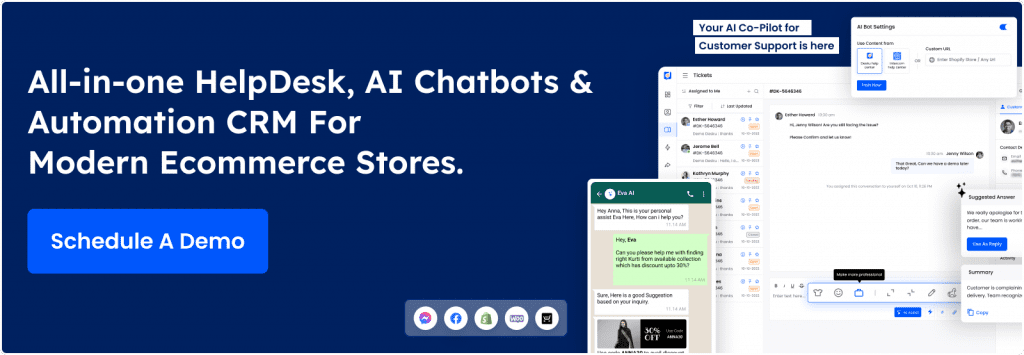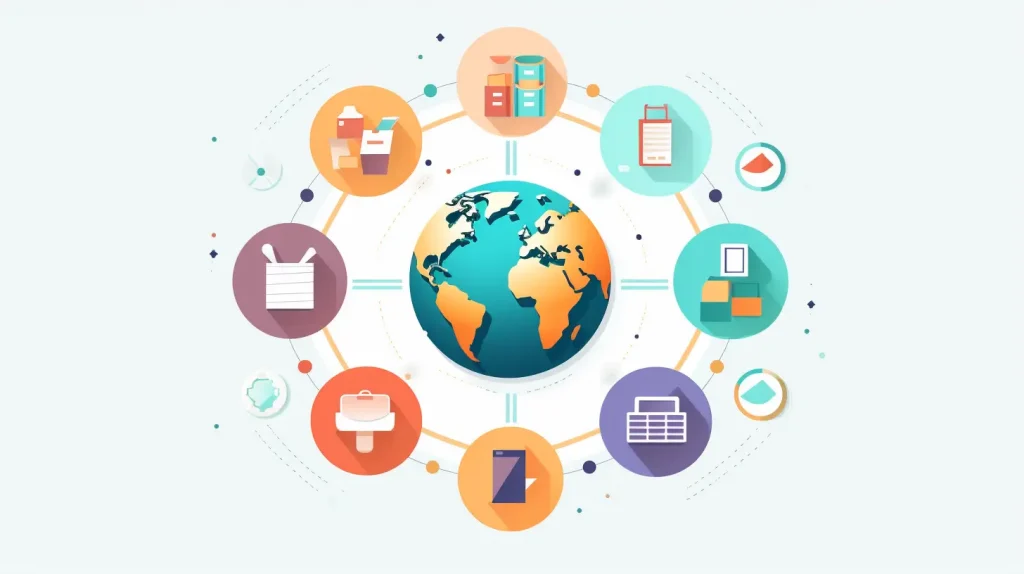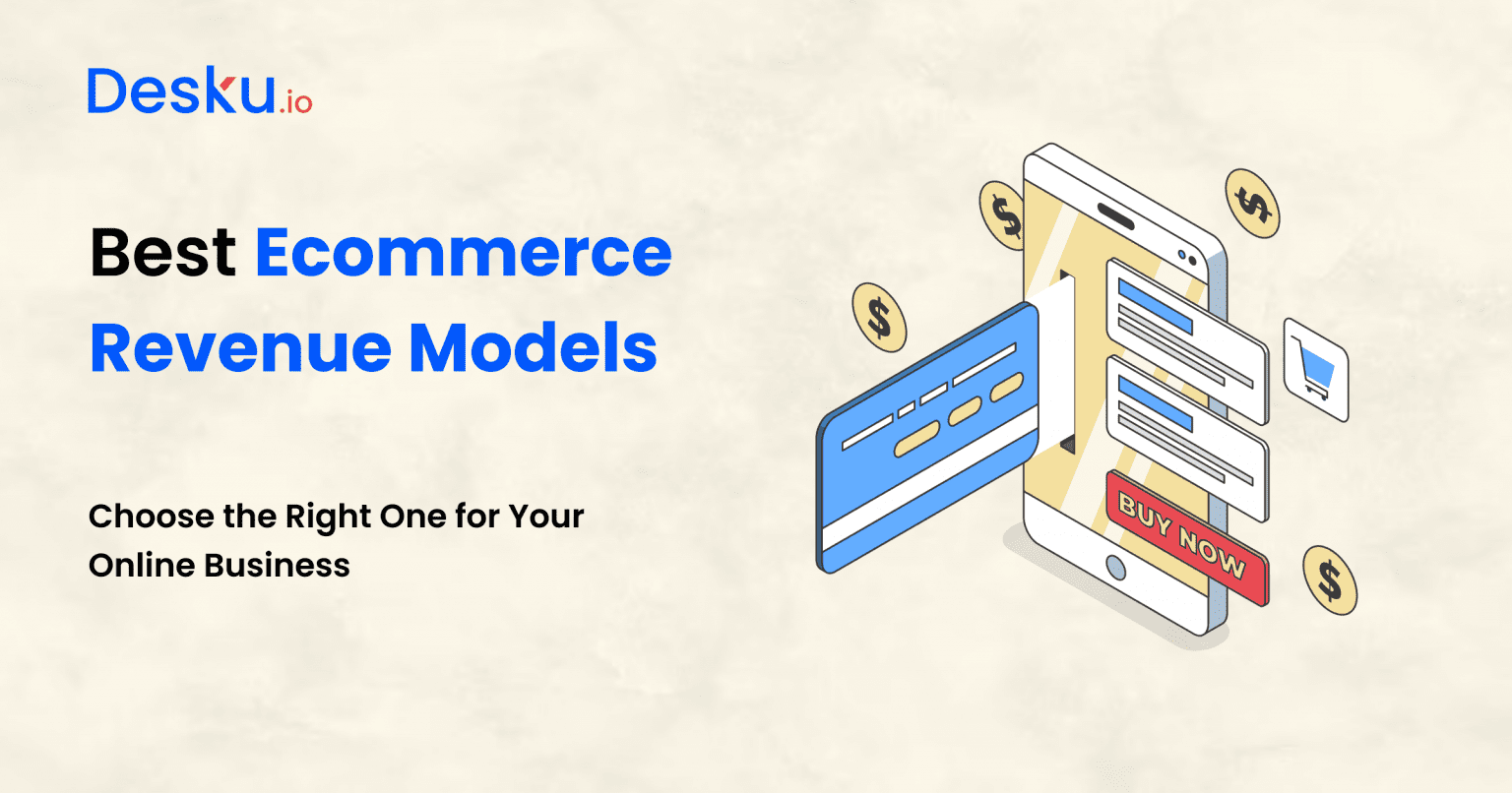As you navigate the world of ecommerce revenue models, the question arises: which one will best propel your online business towards success? The market is vast, offering a variety of pathways to investigate.
Each model holds a unique set of advantages, intricacies, and potential pitfalls that could greatly impact your venture’s bottom line.
So, before you make your decision, consider this: the choice you make now could shape the future trajectory of your online business.

Fact : Retail revenue tipped the $6 trillion mark – and that number is expected to be higher in 2024 and beyond.
Understanding the Different Types of Ecommerce Business Models
Understanding the different types of ecommerce business models is essential for making informed decisions that drive profitability and growth.
- Ecommerce Business Models Overview:
- B2C (Business to Consumer): Involves selling products or services directly to individual consumers.
- B2B (Business to Business): Focuses on transactions between businesses, typically involving bulk transactions or services aimed at other companies.
- C2C (Consumer to Consumer): Enables transactions between consumers, often facilitated by a third-party platform that provides a marketplace.
- C2B (Consumer to Business): Allows individuals to sell products or services to businesses, reversing the traditional business-to-consumer model.
- Key Considerations:
- Each model is tailored to specific transaction types and customer relationships, influencing the potential revenue streams for online businesses.
- Understanding the differences between these models is crucial for selecting the one that best matches your target market and desired revenue strategies.
7 Ecommerce Revenue Models

When contemplating the revenue models for your online business, it’s essential to investigate options like Sales, Advertising, Subscription, Transaction Fee, and Affiliate models.
Each model offers distinct ways to generate revenue and presents unique opportunities for your online venture.
1. Sales Revenue Model
Opt for the sales revenue model in ecommerce to drive profitability through online product sales, a strategy exemplified by successful brands like Gymshark and ColourPop Cosmetics.
- Efficiently manage inventory to meet customer demands.
- Guarantee timely fulfillment of orders to maintain customer satisfaction.
- Implement strategic planning to overcome operational challenges.
- Focus on maximizing profit from product sales in B2C online stores.
2. Advertising Revenue Model
Utilizing the Advertising Revenue Model in ecommerce involves capitalizing on generating income through displaying ads from third-party advertisers on your platform.
This model can operate on pay-per-click or pay-per-impression structures, offering flexibility in revenue generation.
Platforms like Google Ads and Facebook Ads harness this model to monetize their user base effectively. However, challenges such as ad blockers and ad fatigue among users can impact revenue streams.
Despite not directly selling products or services, the Advertising Revenue Model focuses on strategic ad placements to drive income. By understanding the dynamics of this model and adapting to changes in user behavior, you can optimize ad revenue on your ecommerce platform while providing value to third-party advertisers.

3 Subscription Revenue Model
The Subscription Revenue Model in ecommerce generates recurring income by charging customers at regular intervals for access to products or services.
Companies like Dollar Shave Club and Birchbox have successfully utilized this model to create reliable revenue streams.
This model is ideal for businesses offering products or services that require regular replenishment or subscription boxes.
Challenges associated with this model include managing accounting/reporting for recurring payments and potentially lower conversion rates compared to one-time sales.
Subscriptions provide a predictable revenue stream, but businesses must focus on retaining and satisfying subscribers to guarantee long-term success.
4. Transaction Fee Revenue Model
Shifting from subscription-based revenue models, the transaction fee revenue model in ecommerce involves charging a fee for facilitating transactions on a platform. Platforms like Etsy, eBay, and Craigslist utilize this model to generate revenue without the need for warehousing or managing inventory, focusing on profits from third-party sellers.
While earning revenue from transactions can be profitable, it may pose challenges for many ecommerce startups due to its structure and scalability requirements. Thoughtful consideration of the platform’s design is necessary to guarantee the feasibility of the transaction fee revenue model.
5. Affiliate Revenue Model
If you’re interested in broadening your revenue streams in ecommerce, consider exploring the affiliate revenue model. Here are some key points to help you understand how this model can benefit your online business:
- Affiliate Marketing: Partner with other businesses to earn commissions for referrals.
- Commission: Earn revenue by promoting products or services and receiving a commission for successful referrals.
- Referrals: Drive traffic to partner businesses and earn from customer conversions.
- Low-Risk: Benefit from a cost-effective model where you pay for actual conversions or sales, minimizing financial risks.
6. Agency Revenue Model
Considering various revenue models for your online business, the Agency Revenue Model stands out for its focus on providing specialized services to clients for a fee.
In this model, ecommerce agencies offer expertise in digital marketing, SEO, web design, and more to help businesses succeed online. Revenue can be generated through one-time projects, ongoing retainer contracts, or performance-based fees.
This approach allows agencies to cater to specific client needs and provide customized solutions for online growth. Successful agency revenue models are built on strong client relationships, industry knowledge, and a commitment to delivering measurable results. By offering tailored services and maintaining positive client interactions, ecommerce agencies can thrive in the competitive digital landscape.
7. Sponsorship Model Revenue
To broaden your online business revenue streams, consider the Sponsorship Model Revenue, which involves partnering with brands to showcase their products or services on your ecommerce platform. By incorporating this model, you can benefit from:
- Increased Visibility: Brands paying for sponsored placements can attract more customers to your platform.
- Diversified Revenue: Earn revenue through featured sponsored content, ads, or collaborations with various brands.
- Brand Partnerships: Building partnerships with brands can lead to mutual benefits and long-term collaborations.
- Steady Income: Implementing effective sponsorship strategies can provide a consistent stream of income for your ecommerce business.

Types of Ecommerce Business Models
When considering types of ecommerce business models, it’s essential to understand options like B2C, B2B, B2B2C, B2G, and C2B.
Each model serves distinct purposes, from direct sales to customers to transactions between individuals and businesses.
1. B2C (Business-to-consumer)
In the domain of online commerce, the B2C (Business-to-consumer) model stands out as a prevalent and direct avenue for businesses to engage with end-users and drive sales. When considering B2C e-commerce, it’s essential to understand the dynamics involved:
- Utilize Customer Interactions: B2C models involve direct engagement with end-users, requiring effective customer service strategies.
- Competition: In the B2C landscape, businesses face fierce competition from numerous sellers targeting the same market.
- Online Platforms: B2C businesses utilize online platforms to reach a large customer base and drive sales efficiently.
- Large Customer Base: B2C models target a broad audience of end-consumers, offering products and services directly to this extensive customer base.
2. B2B (Business-to-business)
Understanding the intricacies of B2B (Business-to-business) ecommerce models is essential for optimizing revenue generation and fostering long-term partnerships with other businesses.
B2B ecommerce involves selling products or services to other businesses, focusing on meeting their specific needs and requirements. This model often includes longer sales cycles and negotiations due to the complexity of business-to-business transactions.
Businesses operating in the B2B sector usually target a niche customer base with a focus on building long-term relationships and trust. B2B ecommerce typically involves higher order values and repeat purchases, leading to potentially more stable revenue streams.
To succeed in B2B ecommerce, customized pricing structures, contract negotiations, and tailored solutions are often necessary to cater to the unique demands of business clients.
3. B2B2C (Business-to-business-to-consumer)
To effectively implement the B2B2C (Business-to-business-to-consumer) ecommerce model, collaborative partnerships with other organizations are essential for expanding your reach to end consumers. This model combines elements of B2B and B2C to reach a broader customer base and typically requires coordination between multiple businesses. Companies utilizing the B2B2C model often benefit from the established customer base and trust of the partnering organization. Strategies within this model can improve brand visibility, market reach, and overall customer experience by leveraging existing partnerships.
- Foster strong relationships with partnering businesses to guarantee seamless collaboration.
- Focus on delivering high-quality products or services to end consumers through joint efforts.
- Utilize the trust and credibility of your partners to strengthen your brand’s reputation.
- Implement effective communication channels to streamline operations and boost customer satisfaction.

4. B2G (Business-to-government)
When engaging in the B2G (Business-to-government) ecommerce model, your business must navigate specialized strategies and compliance tailored for selling services and products directly to government agencies. B2G e-commerce involves dealing with government contracts and procurement processes, necessitating a well-established business to navigate these complexities effectively.
Vendors operating in the B2G space may find opportunities for growth and benefits by participating in programs like the SBA 8(a) program. Unlike more common e-commerce models, B2G focuses on selling services specifically to government entities, which can involve demographic ownership considerations that offer advantages in certain scenarios.
To succeed in B2G transactions, businesses need to develop specialized strategies to meet the unique demands and compliance requirements of government agencies.
5. C2B (Consumer-to-business)
In the C2B (Consumer-to-business) ecommerce model, consumers take on the role of service or product providers to businesses, driving revenue through their contributions.
- Consumers actively participate in revenue generation in the C2B business model.
- User-generated content is a key component of C2B platforms.
- Affiliate marketing strategies are often utilized in the C2B model.
- The C2B model shifts traditional business dynamics by leveraging consumer contributions for business value.
6. D2C (Direct-to-consumer)
The D2C (Direct-to-consumer) model transforms online retail by enabling brands to sell products directly to customers, eliminating intermediaries for a more personalized shopping experience. This model relies on small-business marketing strategies, emphasizing the development of direct relationships with consumers.
D2C businesses often collaborate with fulfillment centers to improve order processing and shipping efficiency. Particularly common in sectors like mattresses, the D2C model empowers brands to oversee the entire customer journey from product creation to delivery.
Significantly, the D2C model excels at gathering valuable customer data and feedback, aiding in the continuous improvement of products and services. By leveraging direct interactions with consumers, D2C businesses can tailor offerings to meet customer preferences and improve overall satisfaction.
7. C2C (Consumer-to-consumer)
The shift to the C2C (Consumer-to-consumer) model indicates a move towards peer-to-peer transactions on ecommerce platforms like eBay.
- C2C platforms enable individuals to list and sell products directly to other consumers.
- These platforms act as intermediaries, facilitating transactions between users.
- Fees or a percentage of sales are commonly charged by C2C platforms.
- C2C models encompass a wide range of goods and services, including physical items, digital products, and rentals.

7 Unique Strategies to Boost Your Ecommerce Revenue
To boost your ecommerce revenue, consider making your store mobile-friendly, using high-quality product photos, adding social proofs, keeping your website speed high, and offering exciting discounts for customers.
These strategies can improve user experience, build trust, and encourage conversions, ultimately leading to increased sales and revenue for your online business.
1. Make Your Store Mobile-friendly
Optimize your online store for mobile users to maximize ecommerce revenue and boost customer engagement.
To make your store mobile-friendly, consider the following:
- Implement responsive design for seamless shopping experiences on all devices.
- Focus on mobile optimization to increase conversion rates by up to 160%.
- Offer mobile-friendly payment options to elevate the checkout process.
- Streamline checkout processes to reduce friction and improve the overall shopping experience for your customers.
2. Use High-quality Product Photos
Invest in high-quality product photos to greatly improve your ecommerce revenue potential. Online shoppers heavily rely on visuals when making purchasing decisions. High-quality product photos not only boost the look of your ecommerce websites but also increase conversion rates by up to 30%.
Detailed and visually appealing images provide customers with accurate representations, reducing product returns and boosting customer satisfaction. Additionally, quality product photography helps establish trust with online shoppers and uplifts your brand reputation.
Professional images can lead to higher engagement levels, social shares, and overall online visibility. By investing in professional photography for your products, you can expect a significant return on investment through improved sales and enhanced customer satisfaction.
3. Add Social Proofs
Boosting your ecommerce revenue potential through the incorporation of social proofs can greatly impact your online business success. By strategically implementing social proofs, you can increase conversion rates, build trust with customers, and drive more sales.
Consider the following tactics to harness social proofs effectively:
- Utilize social media influencers to reach a wider audience and bolster credibility.
- Display trust badges such as SSL certificates to boost customer confidence in your website.
- Implement scarcity tactics like limited-time offers to create a sense of urgency and drive sales.
- Showcase customer testimonials and reviews to provide social validation and increase conversion rates significantly.
These strategies can help you establish a strong online presence and maximize your ecommerce revenue potential.
4. Keep Your Website Speed High
Boosting your ecommerce revenue potential starts with ensuring your website maintains high speed to drive conversions effectively. Faster website speed can lead to a 7% increase in conversion rates, directly impacting your revenue. Conversely, a mere one-second delay in page load time can result in a 7% loss in conversions, affecting your bottom line.
Mobile users expect sites to load in 2 seconds or less, making optimization essential for revenue growth. Google even considers page speed when ranking sites, impacting visibility and potential revenue. By implementing strategies like image optimization, reducing server response time, and utilizing content delivery networks, you can significantly enhance your ecommerce revenue by improving website speed.

5. Offer Exciting Discounts for Customers
To maximize your ecommerce revenue potential, consider implementing appealing discount strategies that engage customers and boost sales. When offering discounts, think about implementing the following strategies:
- Utilize tiered discount structures: Encourage customers to spend more by activating higher discounts based on order value.
- Provide exclusive discounts: Increase customer retention by offering special discounts to loyal customers or members.
- Utilize personalized discount codes: Improve the shopping experience by tailoring discounts based on customer behavior or preferences.
- Collaborate for unique discount codes: Partner with influencers or other businesses to offer one-of-a-kind discount codes that attract new customers and boost sales.
6. Provide Multiple Payment Options
Consider guaranteeing your payment options to optimize your ecommerce revenue potential. Studies in the ecommerce industry suggest that offering multiple payment methods can increase conversion rates by up to 30%.
By providing diverse payment options like credit cards, digital wallets, and buy now pay later choices, you can cater to various customer preferences. Accepting international payment methods such as PayPal and Alipay can attract a global customer base, ultimately boosting revenue for your online business.
Make sure the implementation of secure payment gateways and encryption technology to build customer trust and reduce cart abandonment rates during checkout. Additionally, integrating seamless payment processes across different devices, including mobile phones and tablets, improves user experience and encourages repeat purchases.
7. Add Free Shipping
To greatly boost your online business revenue potential, incorporating free shipping strategies is a proven and effective approach. When you offer free shipping, you can experience a surge in online orders by up to 30%, thereby increasing your revenue.
Implementing a minimum order value for free shipping can also increase your average order value by 30% or more. Providing free shipping on returns can strengthen customer loyalty, leading to repeat business and potentially improving customer retention by up to 80%.
Additionally, utilizing free shipping promotions during peak shopping seasons can result in a significant revenue surge, driving more sales and increasing profitability. Incorporating free shipping as part of a loyalty program can further enrich customer engagement and increase their lifetime value.
Conclusion
To sum up, selecting the right ecommerce revenue model is crucial for the success of your online business. Remember, ‘you reap what you sow.’
So, take the time to analyze your goals, target audience, and the unique benefits of each model to make an informed decision that will drive your ecommerce revenue to new heights.
Choose wisely, and watch your online business flourish.





